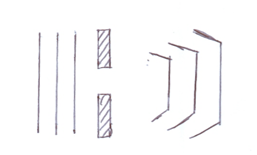Question 10
(a) (i) What is resonance?
(ii) State two examples of resonance.
(iii) Differentiate between loudness and intensity of sound.
(b) When a ray is refracted through a rectangular glass prism,
which of the following properties of the ray will change?
Wavelength, frequency and speed.

(d) A diverging lens of focal length 18.0 m is used to view a shark that is 90.0 m away from the lens. If the image formed is 1.0 m long, calculate the:
Part (a)(i): Performance was fair as many candidates were able to render the correct definition.
(ii) Several candidates had vague ideas as the examples given were not detailed.
(iii) Only few candidates gave a correct pair to score the allotted mark.
Observation
Part (b): This question required the knowledge of refraction as it relates to wavelength, frequency and speed and it was well attempted.
Part (c): Majority of the candidates were able to copy the diagram. Amazingly some candidates found it difficult even to copy the given diagram correctly. Teachers should not relent in taking advantage of always using illustrations in the classroom. The pattern of the wave after passing through the opening were poorly drawn.
Part (d): Majority of the candidates were able to write the lens formula but were unable to substitute the date correctly the data because they lacked the knowledge of functionality of the object and image when they are real or virtual. Generally, performance was average.
The expected answers are:
10. (a)(i) Resonance
A phenomenon which occurs whenever a body is set in oscillation at its own natural frequency as a result of impulses received from another body vibrating with the same frequency.
(ii) Resonance examples
e.g. - repeated jumping of a diver at the free end of a diving board causes the board
to resonate.
- Xc equals XL in an L-C-R series circuit for tuning of radio set.
- rattling of car engine at high speed causing vibration of the body of the car.
- loud sound from vibrating prongs of a tuning fork.
- bridge vibrating under uniform matching of soldiers
(Accept any other valid example)
(iii) Any correct pair
Intensity |
Loudness |
The time rate of flow of energy per unit area perpendicular to the direction of propagation of the sound. |
The magnitude of the sensation resulting from sound reaching the ear. |
(b) Changed wave properties are :
Wavelength

(c)
Diagram correctly copied Correct pattern
(d) + = OR + =
+ =- =
v = - 15 m
v = 15 m
M = =
= ho = 6.0m
